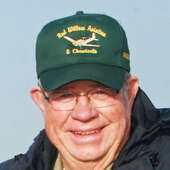- Sweatshirts, Jazzercise, and an unforgiving political climate (11/19/24)
- After the election: Lessons from history (11/5/24)
- Candy or cash: candidates and causes trick-or-treat for donations (10/29/24)
- You are fired! (10/1/24)
- Enduring heritage: Model Tís and Nebraskaís Unicam (9/24/24)
- YMCA project, coming changes and another attack (9/17/24)
- Class of '55 to share memories for Heritage Days (9/10/24)
Opinion
A lot more pleasant way to travel
Saturday, March 8, 2008
OCALA, Fla. -- Earlier this week TV news showed a short video of the pilot in an Airbus airliner really messing up a landing attempt somewhere in Germany.
The airplane made quite a lot of gyration with the left wing touching the ground at one point before the pilot stoked up the fires and went around to try again.
Not shown was the responses of the 100 some passengers on board who were fortunate enough to ride through what must have looked like a rodeo bucking bronco rider's view of the world. The excuse given was that there was a bad cross wind at the time of the landing attempt. In my opinion that pilot needs more practice and I am sure he will be doing just that in a flight simulator before carrying passengers again.
Sometimes one has to sacrifice and so I am in sunny Florida again, 70 degrees as I write this Friday morning. The mission this time is to do annual flight simulator training for the twin engine aircraft I fly for a living. Sim training is a safe way of practicing those equipment malfunctions that can have a disastrous outcome if mishandled in the real airplane. I like to describe it as practicing the things that passengers feel uncomfortable doing in the real airplane. Somehow looking out the window and seeing one of the propellers standing at attention seems to bother passengers while the pilot up front is enjoying the challenge.
Modern day flight simulators are technological marvels. The one that I fly is a nose section taken from an actual (probably wrecked) aircraft and bolted to the floor inside a large building. The windshield glass is left vacant and the facing wall is actually a movie projection screen. Behind the cockpit is an instructor's station where he commands the computers that generate all our problems. We do our normal start up, taxi out and run-up procedures and then take off on what looks like a real runway. As we climb, turn, maneuver, or descend all the appropriate scenes change right before our eyes so that it takes no imagination at all to believe that we are actually flying. For me there is always the niggling little realization in the back of my mind that this thing really is bolted to the floor but "close enough".
There in our shirt sleeves at zero altitude and airspeed we experience failures of hydraulic, electrical, environmental (cabin heating, cooling and pressurization), and flight instrument systems as well as engines that don't produce power. During the process we practice all manner of instrument flight procedures, most with two engines operating but some with only one. All in all it is a wonderful review even though it is an insurance requirement and a tad on the expensive side.
Airline pilots do simulator training at least twice a year. Their simulators are even more technologically advanced and include motion and much better graphics for the visual portions of flight. For the instrument training segments, theirs and ours, the scene out the window is a lot like looking out the inside of a milk bottle. Visually it is all featureless white just what we experience in the real world flying in the clouds. It is part of the training process that has made airline and business travel today the safest mode of transportation the world has ever seen.
When traveling cross country in an automobile we simply depart the interstate when the fuel gauge reads low pull into the nearest gas station and fill our tank. In an airplane the process takes a little more planning. For pilots there is a handy little program on the internet reporting current fuel prices at nearly every airport in the USofA. Information is also available as to runway length and direction even down to the availability of courtesy cars and nearby restaurants. On the trip southeast I chose to land at Meridian, Mississippi a place where I have never been before.
The fuel price was good, only $3.88 a gallon (it is coming for auto gas too) and great facilities it being a former Air Force jet fighter base. We found the ramp crowded with Air Force trainers from nearby Columbus AFB, Georgia. These were T-45 Jayhawk that students headed to fly airplanes like tankers, bombers and cargo aircraft use to train in. We also discovered free chili dogs, ice cream and popcorn. What a nice place to take a break during pilot training while replenishing their load of jet fuel. It was a pleasant interlude to associate for a few minutes with the sharp young men and women that will be our military pilots and future Air Force leaders.
Flying my own airplane avoided all the hassle and humiliation the airline passenger experiences today courtesy of TSA. We showed up in just enough time to get the airplane ready to go not the mandatory two hours of wasted time in the commercial world.
Ann carried a paring knife in her purse to cut the apples we snacked on. She worked on needle craft using steel needles and scissors, all no's no's on today's airliners. It may be a little more expensive, take longer and probably is less safe than flying the big equipment but flying my own is a lot more pleasant way to travel.
That is the way I see it.

